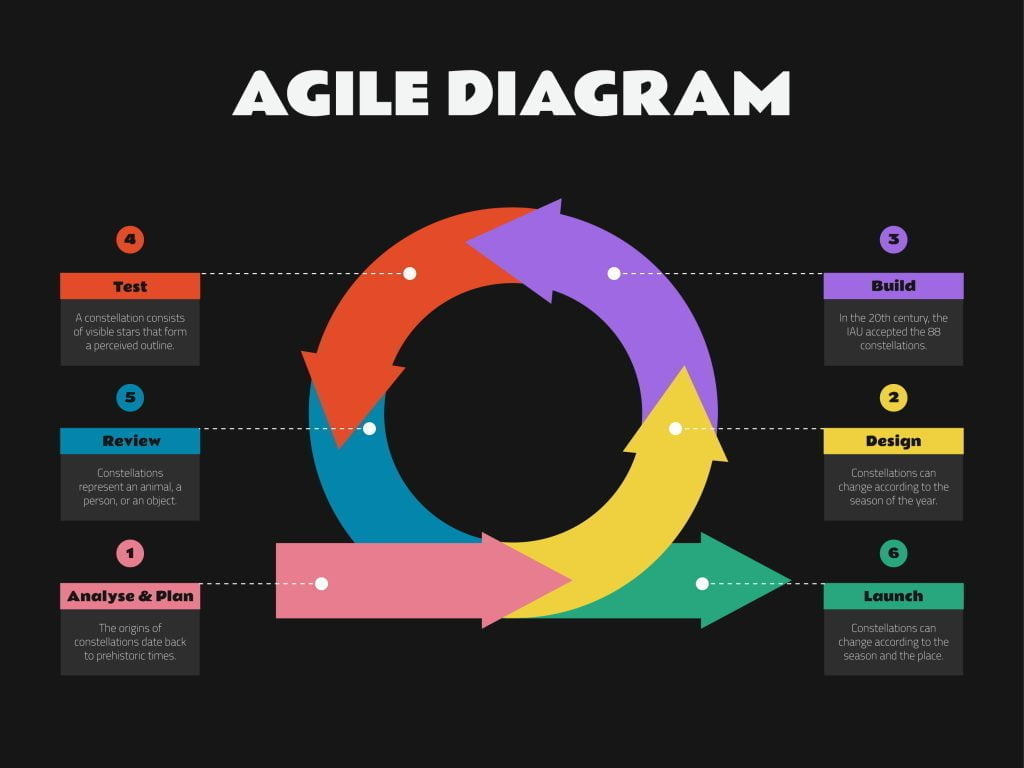One of the most common inquiries in the realm of project management and software development is about the distinction between Agile and Scrum. While both terms are frequently mentioned in the same breath and share a commitment to delivering high-quality work efficiently, their concepts often lead to confusion.
This exploration aims to clarify these methodologies, sort out their unique attributes and how they complement each other within dynamic work environments. Whether you’re new to these approaches or looking to refine your understanding, this discussion seeks to clear out Agile and Scrum differences.

Before we delve deeper into the distinctions between them, it’s essential to first understand the foundational meanings of Agile and Scrum. Meanwhile, you may explore more of our training on Agile and Scrum to deepen your understanding and skills here.
What is Agile?
Agile represents a highly collaborative and adaptable methodology designed to enhance task execution efficiency, especially in the realm of software development. This approach prioritizes teamwork, open communication, and flexibility in response to changing project requirements, enabling teams to deliver high-quality software solutions rapidly and effectively.
What is Scrum?
Scrum, as a framework within the Agile methodology, promotes enhanced collaboration and operational efficiency in software development projects. It organizes work into sprints – short, focused cycles – encouraging teams to work cohesively and dynamically. This structured yet flexible approach ensures that software development progresses in a manageable, iterative manner, facilitating rapid delivery of value and continuous improvement in response to evolving project demands.
Agile…
Now, let’s dive deeper into the Agile methodology, exploring its principles and how it revolutionizes software development.

● Focus
The essence of Agile lies in its unwavering commitment to adaptability, setting it apart as a transformative approach in project management. Agile methodologies are meticulously crafted to embrace changes in requirements or shifts in priorities with agility and grace. This adaptive nature ensures that Agile projects can navigate through evolving landscapes and adjust their course as necessary, promoting resilience and responsiveness.
Contrasting sharply with traditional, more inflexible project management approaches, Agile stands out for its dynamic framework. Where conventional methods depend on extensive planning and a fixed project scope established at the outset, Agile recognizes the reality of fluctuating project needs and the potential for change. In traditional settings, deviations from the original plan are often viewed as setbacks, causing disruptions and challenges. However, Agile transforms these potential obstacles into opportunities for growth and improvement, highlighting its revolutionary approach to managing projects in a way that is both flexible and focused on delivering optimal outcomes in the face of uncertainty.
● Delivery
Agile methodologies stand out for their flexibility in delivery approaches, providing teams with the autonomy to choose how they release working software – often in short, manageable iterations. This iterative delivery model is key to Agile’s success, enabling the collection of early feedback from users or stakeholders, which in turn, allows for the rapid integration of changes or improvements. Such a model significantly enhances the project’s adaptability and responsiveness to evolving requirements.
By segmenting the project into these shorter cycles, teams can maintain a continuous flow of progress, ensuring that each iteration brings them closer to their final goal with increased efficiency. This approach not only accelerates the development process but also ensures that the final product more accurately reflects the user’s needs and expectations, thanks to the ongoing input and refinements made along the way.

● Planning
Agile methodologies approach planning with a distinctive combination of upfront structuring and persistent flexibility. Acknowledging the essential role of preliminary planning for establishing the direction and scope of a project, Agile principles stress the value of an adaptable planning process throughout the project’s duration. This focus on flexibility enables Agile teams to adeptly respond to emerging insights, unforeseen challenges, or shifts in the project’s scope. Rather than sticking rigidly to an original plan, Agile methodologies champion the ongoing evaluation and modification of the project’s strategy.
This adaptable approach to planning allows project teams to seamlessly integrate new information, refine processes, and alter strategies when necessary, aligning the project more closely with evolving client needs, market dynamics, and technological advances. Through striking a balance between initial planning and continuous adjustment, Agile positions teams to tackle development complexities with both agility and accuracy. The result is an enhanced ability to achieve project goals and exceed stakeholder expectations, demonstrating the power of Agile’s flexible planning in driving successful outcomes.
● Roles
In the Agile framework, the concept of team roles takes on a transformative perspective, emphasizing self-organization as a key principle. Unlike traditional methodologies that often define strict, prescribed roles for team members, Agile empowers teams with the autonomy to determine their own operational dynamics. This empowerment is rooted in the belief that those who are closest to the work are best positioned to understand how to accomplish it effectively.
As a result, Agile teams are entrusted with the flexibility to organize themselves, decide on their workflows, and distribute tasks in a way that they collectively deem most efficient for achieving their objectives. This approach not only fosters a sense of ownership and accountability but also encourages a collaborative and innovative environment where every team member has a stake in the project’s success. Agile fosters a culture of leadership by empowering team members to take initiative and make decisions.
Scrum…
Now that we’ve explored the fundamentals of Agile, what’s next on our journey? Let’s dive deeper into the world of Scrum to uncover how it builds upon Agile principles and applies them in a structured framework.

● Focus
Scrum embraces the foundational principles of Agile, infusing them with a structured methodology that enhances their practical application. This approach meticulously organizes the workflow into short, defined cycles known as sprints, facilitating concentrated efforts on specific tasks. These sprints are instrumental in promoting disciplined work habits, allowing teams to dedicate their full attention to a limited set of objectives within each cycle.
This structured cadence not only optimizes productivity but also integrates periodic reviews at the end of each sprint. These review sessions are crucial for assessing progress, addressing any deviations from the project’s trajectory, and adapting to any shifts in requirements or priorities. By incorporating these regular evaluations, Scrum ensures that projects remain agile and aligned with evolving needs, effectively bridging the gap between Agile’s theoretical values and their tangible implementation in dynamic project environments.
● Delivery
Scrum distinguishes itself with a well-defined delivery methodology, centered around the concept of producing potentially shippable increments of the product at the conclusion of each sprint, which typically spans 2 to 4 weeks. This approach not only ensures a steady pace of tangible progress but also emphasizes the importance of adaptability and responsiveness to feedback. At the end of every sprint, the team engages in a critical review of the work completed, reflecting on both achievements and areas for improvement.
This review process is instrumental in guiding the adjustments to the project plan for the forthcoming sprint, incorporating valuable insights and feedback gathered. Such a structured yet flexible delivery model is an example of Scrum’s commitment to continuous improvement, enabling teams to refine their processes, enhance product quality, and more effectively meet customer needs with each successive iteration.
● Planning
Scrum introduces a systematic approach to project planning through well-defined events that occur within each sprint, most notably the Sprint Planning session. This session is pivotal in establishing the direction and objectives for the upcoming sprint, setting a clear agenda for the team to follow. Despite this structured approach to planning, Scrum maintains its agility by allowing for adjustments to the sprint backlog as the work progresses.
This flexibility ensures that the team is not rigidly bound to an initial plan but can respond dynamically to new insights, challenges encountered, or changes in project scope. As a result, the sprint backlog becomes a living document that evolves in tandem with the team’s understanding of the project requirements and their capacity to deliver. This blend of structured planning with the capacity for in-flight adjustments exemplifies Scrum’s balanced approach, ensuring that planning enhances rather than hinders the team’s ability to deliver value incrementally and adaptively.
● Roles
In the Scrum framework, the roles are distinctly defined to optimize team functionality and project progression. These roles include:
1. Product Owner
This individual is the custodian of the product backlog, holding the responsibility for its content, prioritization, and updates. The Product Owner acts as a liaison between the stakeholders and the development team, ensuring that the features and tasks included in the backlog align with business goals and customer needs.
Their decisions shape the direction of the project, making their role critical in guiding the team towards delivering the most valuable product increments. Explore the two specific types of training: the Professional Scrum Product Owner and the advanced.
2. Scrum Master
Serving as the guardian of the Scrum process, the Scrum Master ensures that the team adheres to Agile principles and practices. They are not just facilitators but also coaches, helping the team work cohesively, overcome obstacles, and remain focused on achieving sprint goals.
The Scrum Master also works to create an environment where the team can perform at their highest level, advocating for continuous improvement and effective communication within the team and with external stakeholders. As with the Product Owner, there are two specific types of training available, namely the Professional Scrum Master and the advanced.
3. Development Team
Comprising professionals who are self-organizing and cross-functional, the Development Team is tasked with creating the product increments. This team collaborates closely to design, develop, and test product features within each sprint. Their self-organizing nature means they make collective decisions about how to best achieve their objectives, encouraging a sense of ownership and accountability among members.
The emphasis on cross-functionality ensures that the team possesses all the skills necessary to complete the work without relying on individuals outside the team, fostering a comprehensive, collaborative approach to project development. Explore the specific training for this role, namely Applying Professional Scrum for Software Development (APS-SD).
Together, these roles form the backbone of the Scrum framework, creating a structured yet flexible environment that encourages efficiency, collaboration, and continuous improvement.
Summary of the Difference between Agile and Scrum
| Aspect | Agile | Scrum |
| Definition | A broad philosophy offering a flexible approach with core values and principles | A specific framework within Agile, providing a structured implementation of Agile principles with defined roles, events, and artifacts |
| Focus | Emphasizes adaptability to changes in requirements or priorities | Follows Agile’s core values with structured sprints for focused work and regular reviews to stay aligned with changing needs |
| Delivery | Offers flexible delivery methods for early feedback and quick changes | Has a defined delivery approach, focusing on potentially shippable product increments at the end of each sprint, followed by reviews and adjustments |
| Planning | Promotes flexibility in planning, allowing adjustments based on new information | Includes defined planning events within sprints but maintains adaptability, permitting adjustments to the sprint backlog based on progress and learnings. |
| Roles | Centers on self-organizing teams without prescribed roles, encouraging internal decision-making | Defines specific roles: Product Owner (manages the product backlog), Scrum Master (facilitates the process), and Development Team (responsible for product increments). |
Agile and Scrum represent complementary yet distinct methodologies in the realm of project management, each designed to cater to unique aspects of project execution. Agile stands as the overarching philosophy, prioritizing adaptability, collaboration, and a responsive approach to project development. It sets the foundational mindset and values necessary for navigating the complexities of modern projects.
In contrast, Scrum operates as a specialized framework within the Agile spectrum, offering a concrete set of practices, roles, and milestones to efficiently apply Agile principles. If Agile is seen as the compass that provides direction and ensures that project efforts are aligned with core values, then Scrum can be viewed as the detailed roadmap, outlining specific steps, checkpoints, and strategies to achieve the project’s goals. Together, they offer a comprehensive toolkit for project teams, enabling them to maneuver through challenges with agility and precision, ultimately leading to successful project outcomes.





